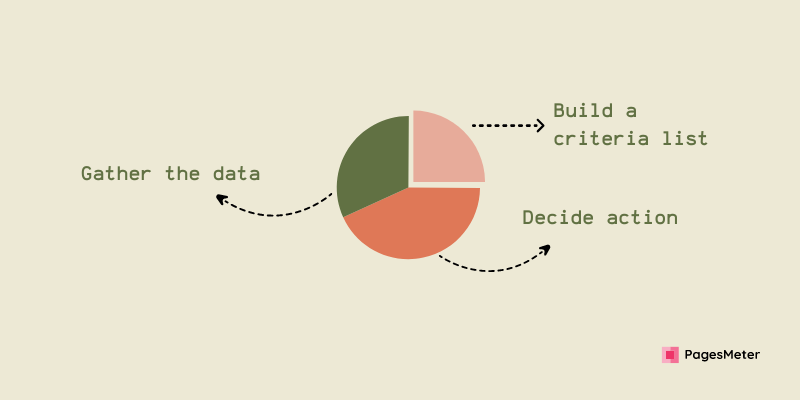- Home /
- Academy /
- Content & SEO Processes /
- Content pruning - A Perfect Guide
Content pruning - A Perfect Guide

As the business continues to invest in its digital presence, content marketing has become a fundamental tool in attracting and hanging on customers. However, with the increasing volume of content being produced, it is easy to fall into the trap of creating more content without considering the quality and relevance of existing content. This is where content pruning comes in.
Basically, Content pruning is the process of strategically removing outdated, irrelevant, or low-quality content from a website or article to improve its overall performance.
In this blog, we will be exploring the benefits of content pruning and how it can enhance a content audit to identify which content needs to be pruned, and how to approach the process to ensure that you are keeping your website or article updated and relevant. We will also discuss that by the impact that pruning can have on search engine optimization(SEO), and how it can improve the user experience for your audience.
What is Content pruning?
Content pruning is the process of taking out the content from the website that has very less value to the business or its clients. Adding to that removing content, pruning is also the process of integrating the content from being listable by the search engines.
Content pruning is commonly related to the pruning of a tree. In the sense of general, trees are pruned to encourage strong growth, considering the plant's health, and maintaining the outer structure and its quality. Gardiner does pruning to save the plants from decaying. Here also we are gonna apply this sort of method by pruning the content for goodness.
Identifying a pack of low-quality and underperformed articles from your website and pruning them is basically what we gonna discuss. this form of disposing of the blogs while casting light on the new and more relatable content for the crowd.
Identifying the people for pruning would be a little different. Well, it can begin like this,
- Copies of articles
- Articles with slight content
- Content that has dismantled keywords
- Articles with old and outdated value and information
- Pages with high bounce rates
- Pages with low traffic
Content pruning is an organized method to clear up the currently existing content, revealing the space, and setting up a direction for the upcoming content marketing. Content pruning is not just about cutting off old outdated content.
Also speaking about the old content it's not always bad well some can still be productive and provide authority to your website. Anyways considering the old outdated content which is lacking in periodical value, slight or unfamiliar to the crowd has nothing to do with your website.
The Content pruning process?
Speaking about the process of Content pruning the following steps will help you how to content the process of Content pruning.
1. Decide what you’re going to audit:
Some content is all-time enduing, which means it has organic traffic and shouldn’t be trashed. But possibly it can be updated with the latest data, examples, and tips.
But other old posts, whether, may be contaminating your rank and blocking up your website with low-quality content.
2. Identify the less-performing pages:
As you got a good feel for your site’s anatomy and what’s still giving value, Make a note of the pages that are performing poorly. Be it getting lesser clicks or they don’t even belong to the site. Also, it is important to understand and find out which are pages that bring down your site and.
3. Determine clearly whether to delete or to improve:
Well, this is the time to make some decisions since you got the key factor that which posts are problematic. Here we have two options:
- To delete the posts totally or
- To improve the underperforming posts.
4. Bring in the backlink and traffic:
Firstly, don’t just observe what are the pages underperforming also construct an original analysis to understand traffic and backlinks. Usually, if a piece of content hasn’t been in the position of trafficking or the clicks of the audience's point of view then it has to be pruned.
Why should you care about Content pruning?
On the whole, you want your content website which has content that contributes to its quality and productivity. The reasons behind all these concepts would be the following:
Good distribution of the link authority:
Considering the link authority makes sure that it is flowing only to the pages that have high value and potential just by pruning the content.
Good general quality:
Increasing the quality of the entire content that matters here just by pruning the content doesn’t add any value to it.
Good user experience:
This could be a good user experience for the clients who are visiting which has become more important to the search engine also.
Better Crawl Budget spending:
Spending Crawl Budget wisely, search engine crawlers spend the Crawl Budget on the site that genuinely matters for the site’s SEO performance.
Benefits of Content pruning
Here are the benefits of Content pruning,
- Increases the SEO rankings
- Increases the link authority distribution
- Enhance your Crawl Budget
- Removes jumbled clutter
- Adding value to the links
- Makes navigation easier
- Keeps the site updated
- Readers to the most reliable content
How often you should prune your content?
Content pruning is not a cake walk especially when it comes to fixing. Every business whether it is large or small, is a baseline process that needs to be visited repeatedly. How much pruning is needed usually depends on the size of your business. Normally, it is commended that large websites review their content every three months.
Not just for the sake it is keeping your content library look fresh, also it enhance marketing teams observe the content performance over the period, and make the changes regarding that.
The reason for that case would be the products and target audience might change and showcase the content which is updated. Also speaking of being updated technology and the standards keep changing so you need to keep the content updated.
How do Content pruning impact SEO and its ranking?
Generally, a myth has been circulating in the industry of SEO that there should be a publication of a certain amount of content on the site on a regular basis for a good ranking periodically.
It’s a fact that providing valuable content and relevant optimized content that answers the queries and share the perception and there will be increased visibility.
Anyways a contrast effect may occur if the content being published is not informed properly and is badly structured and lacks meaning and purpose. It is also essential to review and take count of the content on your page that has been publishing the latest content over the years, they are most probably to be articles that are no longer relevant with the brand and being accurate in terms of their content are not helping the brand to achieve any such goals or with the information.
Conclusion
So finally to conclude, content pruning is an essential process for any website or blog to keep the content fresh, relatable, and effective. By removing outdated and irrelevant content also the owner of the website can improvise their search engine rankings and encourage the user experience and drive more traffic.
However , it is important to approach content pruning with a thought process and strategic mindset , considering the potential impact on SEO and user behavior. By following these practices and updating the content , business can ensure that they are delivering the highest quality content to the clients.
While it may initially seem intimidating, the advantages of Content pruning far outweigh the effort involved. So , if you haven’t it’s time to start pruning the content andv reaping the rewards.
Start using PagesMeter now!
With PagesMeter, you have everything you need for better website speed monitoring, all in one place.
- Free Sign Up
- No credit card required

Content optimization refers to updating your content (text, images, links, code, and other elements) to help search engine algorithms rank your web pages higher.
Rank tracking is the practice of monitoring the rankings that your sites hold in search results for the search terms that interest you. A program that does rank tracking is called a rank tracker.

In content marketing, duplicate content is content that is an exact copy of another piece of content.
Uncover your website’s SEO potential.
PagesMeter is a single tool that offers everything you need to monitor your website's speed.